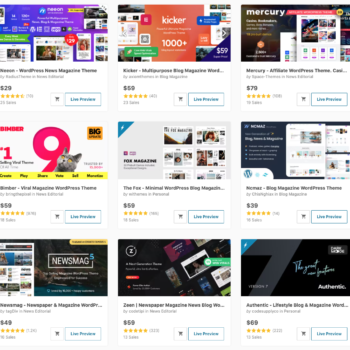Starting a blog is like setting up shop in a bustling online city. Your domain name is the address that helps people find you amidst the crowd. It’s the first impression, the virtual storefront that entices readers to step inside and explore your content. A catchy domain name isn’t just a string of letters; it’s a powerful branding tool that can make your blog memorable and successful.
But with millions of blogs already online, how do you choose a domain name that stands out? Don’t worry, even if you’re a complete beginner, this guide will equip you with everything you need to find the perfect domain name for your blog. Let’s dive in!
Brainstorming: Where Creativity Meets Strategy
Choosing a domain name is a blend of creativity and strategy. You want a name that reflects your unique voice and resonates with your target audience. Start by thinking about your blog’s niche. What topics will you cover? What kind of experience do you want your readers to have?
Let’s say you’re passionate about travel and want to share your adventures with the world. Words like “wanderlust,” “explore,” “journey,” “adventure,” and “globetrotter” might come to mind. Think about the specific aspects of travel you’ll focus on. Are you a budget traveler? A luxury backpacker? A solo female adventurer? Incorporate these nuances into your brainstorming.
Don’t be afraid to experiment with different word combinations, synonyms, and even playful variations. Tools like LeanDomainSearch and NameMesh can be invaluable during this process. They can help you explore available domain names, generate creative suggestions, and even check for similar names already in use.
The Anatomy of a Great Domain Name: Key Characteristics
A catchy domain name is more than just a good idea; it needs to be practical and user-friendly. Here are the essential qualities to look for:
- Brevity is Key: Aim for a domain name that’s concise and easy to remember. Ideally, it should be no more than 2-3 words. Long, complicated names are difficult to recall and prone to typos, which can lead to frustrated visitors and lost traffic.
- Clarity and Pronunciation: Choose a name that’s easy to spell and pronounce, even for those unfamiliar with your niche. Avoid using jargon, hyphens, or numbers that could cause confusion. A clear and straightforward domain name ensures that people can easily find your blog.
- Relevance to Your Niche: Your domain name should give visitors a hint about your blog’s topic. This helps attract the right audience and improves your blog’s search engine optimization (SEO). For example, if your blog is about vegan cooking, including words like “vegan,” “plant-based,” or “recipes” in your domain name can be beneficial.
- Brand Alignment: Think about your blog’s overall brand identity. Does the domain name reflect your style, tone, and target audience? A cohesive brand image strengthens your blog’s identity and makes it more memorable.
Pro tip: Say your potential domain names aloud. Do they sound catchy and natural? Do they roll off the tongue easily? If a name feels awkward to say, it’ll be awkward for others to remember.
Navigating the Domain Name Landscape: Practical Considerations
Securing your domain name involves a few technical aspects. Here’s what you need to know:
- The Gold Standard: .com Domains: When it comes to domain extensions, .com reigns supreme. It’s the most widely recognized and trusted extension, making it the ideal choice for most blogs. However, if your perfect .com name is already taken, don’t worry! Alternatives like .net or .org can also be effective.
- The Trouble with Hyphens and Numbers: While it might be tempting to use hyphens or numbers to secure a variation of your desired name, they often create usability issues. They’re harder to remember, can look unprofessional, and people frequently omit them when typing, leading to missed connections.
- Keyword Stuffing: A No-No: While it’s good to incorporate relevant keywords into your domain name, avoid overdoing it. Cramming in too many keywords can make your domain name look spammy and harm its readability. Focus on creating a name that’s both informative and aesthetically pleasing.
- Act Fast: Check Availability Early: Once you have a few domain names you love, check their availability immediately. Use a domain registrar like Namecheap or GoDaddy to see if the names are taken. This prevents disappointment and allows you to secure your preferred option before someone else does.
Plan B: When Your Ideal Domain Name is Taken
It’s not uncommon to discover that your dream domain name is already registered. But don’t let this discourage you! Here are some strategies to help you find a great alternative:
- Embrace Flexibility: Tweak Your Name: Can you shorten your ideal blog name? Add a relevant word like “the,” “blog,” or “daily”? Sometimes small modifications can make a big difference. For example, if your first choice is taken, try adding a simple word to the beginning or end.
- Scope Out the Competition: If a very similar domain name is already in use, visit the website. Is it an active blog in your niche? If so, it might be best to brainstorm a different name. However, if the website is inactive or unrelated to your topic, you might still have a chance to acquire the domain.
- Know Your Limits: Avoid Compromises: While flexibility is important, there are some compromises you should never make. Avoid misspellings, trademark infringements, and excessively long or confusing names.
FAQs: Addressing Your Domain Name Concerns
Q: Do I absolutely need a domain name to start a blog?
A: While you can technically start a blog on a free platform with a subdomain (e.g., yourblog.wordpress.com), having your own domain name (e.g., yourblog.com) is highly recommended. It gives your blog a professional image, improves credibility, and makes it easier for people to find and remember. You can learn more about starting a blog for the first time in our ultimate guide: guide to starting a blog.
Q: Where can I buy a domain name?
A: Domain names are purchased from companies called domain registrars. Some popular options include Namecheap, GoDaddy, and Google Domains. If you’re looking for a quick and dirty guide to get started, we have a blog post just for that! quick start guide
Q: How much does a domain name typically cost?
A: Domain name prices vary depending on the registrar and the specific name, but they generally cost around $10-15 per year.
Q: Can I change my domain name later if I need to?
A: Yes, you can change your domain name, but it can be a complex process that may temporarily affect your blog’s traffic and search engine rankings. It’s best to choose a domain name you’re happy with from the start.
Q: What if I’m feeling overwhelmed and can’t decide on a name?
A: Don’t overthink it! Sometimes the simplest and clearest names are the most effective. Trust your instincts, choose a name that resonates with you, and remember that you can always refine your branding as your blog grows.
You’re Ready to Launch Your Blog!
Choosing a domain name is an exciting step in your blogging journey. By following this guide, brainstorming creatively, and considering the practical aspects, you’ll be well-equipped to find a catchy, memorable, and effective name for your blog. Be sure to check out our guide on setting up your WordPress blog for a step-by-step walkthrough: WordPress setup guide, and learn how to choose the best hosting plan for your blog to ensure you have the right foundation for success: guide to choosing blog hosting. Happy blogging! 🎉









No Comments
Leave a comment Cancel